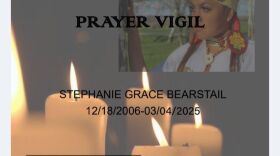-
The film’s producers are using this recognition to ask people to reach out to their representatives to make the Not Invisible Act Commission report available after it was taken offline by the Trump administration.
-
The analysis from the state’s Missing and Murdered Indigenous Persons Task Force also found 105 Native individuals were filed as missing in Wyoming last year, with six of those cases remaining unresolved.
-
There will also be a Missing and Murdered Indigenous Relatives march in Riverton on May 4, along with a run and walk on the Wind River Reservation on May 5.
-
The Bureau of Indian Affairs (BIA) is making new efforts to help solve Missing and Murdered Indigenous Persons (MMIP) cases. Now, the federal agency is using forensic technology to help reunite the remains of Native Americans with their families and tribal nations.
-
A high school student named Stephanie Bearstail died on the Wind River Reservation on Mar. 4. While the cause of her death is still under investigation, people are marching in Riverton this weekend to demand justice.
-
The new liaison positions will serve as the face of communication when it comes to working with local, state and federal partners and agencies on the issue.
-
The Missing and Murdered Indigenous People Crisis is an ongoing issue of national concern. Now, tribes are hoping new measures will get bipartisan support in Congress to help tribal law enforcement solve these cases.
-
The Federal Communications Commission launched a new missing and endangered persons code for its nationwide Emergency Alert System. It will allow law enforcement to send out messages about missing adults to the public through phones, TV and the radio. The code is part of efforts to address the Missing and Murdered Indigenous Persons crisis throughout the country.
-
Earlier this year, the Federal Bureau of Investigation launched a data collection project to gather more information about missing and murdered cases involving Native Americans throughout Wyoming. Over a 90-day period, the agency received 35 tips, including four homicide cases and three missing persons cases. They’d all been previously reported to law enforcement and investigated already.
-
May 5 is the National Day of Awareness for Missing and Murdered Indigenous People (MMIP). This Sunday, there will be a march in Riverton to honor the day and promote action to address a crisis that’s close to home for many.
© 2025 Wyoming Public Media
800-729-5897 | 307-766-4240
Wyoming Public Media is a service of the University of Wyoming
800-729-5897 | 307-766-4240
Wyoming Public Media is a service of the University of Wyoming

Play Live Radio
Next Up:
0:00
0:00
Available On Air Stations











